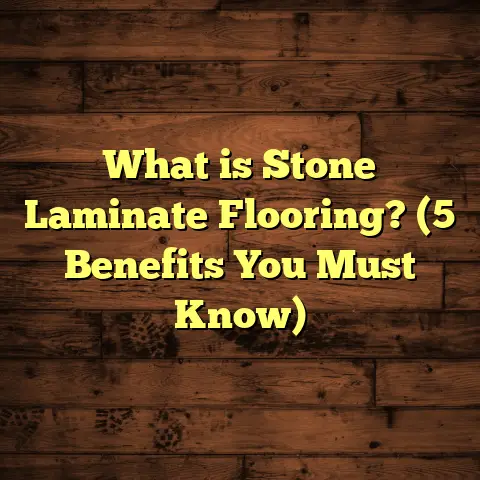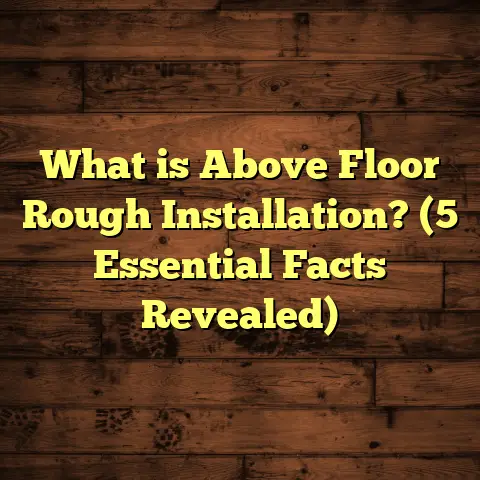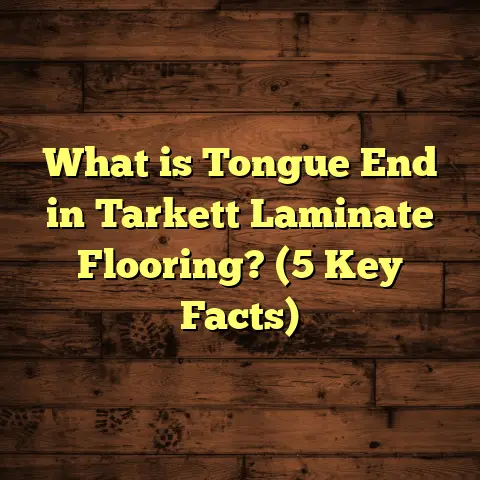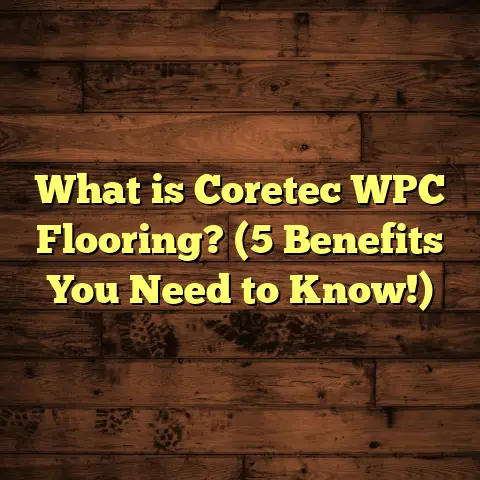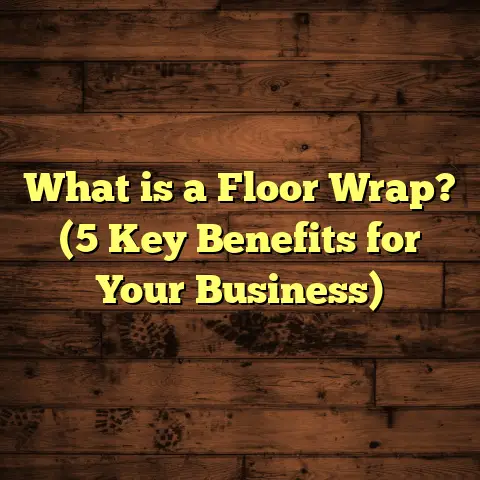What is Commercial LVT Flooring? (5 Benefits for Your Business)
“Flooring is the foundation of a space’s character and functionality. Choose wisely, and it pays off every day.” – Mark Johnson, Flooring Expert
What is Commercial LVT Flooring?
You might have come across LVT flooring in various commercial settings—offices, retail stores, hotels—and wondered, what exactly makes it so popular?
LVT, or Luxury Vinyl Tile, is a type of vinyl flooring that combines durability with high-end looks. But commercial LVT is a specific grade and construction designed to withstand the demands of commercial environments. Unlike residential vinyl options, commercial LVT has thicker wear layers and reinforced cores to handle heavy foot traffic and often harsh conditions.
At its core, commercial LVT consists of several layers:
- Wear Layer: This is a transparent, tough layer that protects against scratches, stains, and scuffs. The thickness here is vital for durability.
- Design Layer: This layer features high-resolution printed patterns that replicate natural materials like wood grain, stone, or ceramic tile.
- Core Layer: Provides stability and support. Often rigid or semi-rigid for commercial versions.
- Backing Layer: Offers cushioning and moisture resistance.
This multilayer setup allows LVT to combine the look and feel of natural flooring materials with the benefits of synthetic resilience.
Why I Started Using Commercial LVT
When I was doing mostly residential flooring jobs at the start of my career, hardwood and laminate were staples. They’re beautiful options but not always practical for businesses.
I recall one early commercial project—a small law office—that installed hardwood floors. Initially, it looked stunning. But within six months, the floors showed wear from constant foot traffic and rolling office chairs. Repairs and refinishing were costly and caused disruptions.
That experience pushed me to explore alternatives that offered better durability without sacrificing style. Commercial LVT caught my attention because it promised resilience and design versatility.
On my next commercial job—a busy retail store—I convinced the client to try LVT. The results were impressive: the floor resisted scuff marks, stains from spills were easy to clean, and the overall look mimicked hardwood so well that customers didn’t suspect it wasn’t the real thing.
From there, I started incorporating commercial LVT more frequently in my projects.
How Does Commercial LVT Compare to Other Flooring Options?
I’ve seen the pros and cons of different flooring types firsthand. Let me share some detailed comparisons from my experience:
Hardwood vs. Commercial LVT
Hardwood floors bring warmth and timeless beauty but come with maintenance challenges in commercial spaces. They scratch easily when exposed to heavy foot traffic or furniture movement. Water damage is another risk—spills or cleaning mishaps can cause warping or staining.
Commercial LVT mimics wood’s look but with greater resilience. It won’t warp or discolor from moisture and holds up better against daily wear. Plus, installation is often faster and less disruptive.
Laminate vs. Commercial LVT
Laminate flooring is affordable and can look good initially but often struggles with water exposure, causing swelling or bubbling. The surface can also chip or peel over time in high-traffic areas.
Commercial LVT offers superior waterproofing and generally a more authentic texture due to embossed surfaces.
Ceramic Tile vs. Commercial LVT
Ceramic tile is extremely durable and water-resistant but can be cold and hard underfoot. Installation is labor-intensive and costly. Tile grout can stain or crack, requiring upkeep.
LVT provides similar water resistance without coldness or hardness, making it more comfortable for standing employees or customers.
Carpet vs. Commercial LVT
Carpet adds comfort and sound absorption but stains easily and traps dirt—problematic in busy commercial spaces.
LVT is easier to clean while still providing some cushioning depending on backing.
Five Benefits of Commercial LVT Flooring for Your Business
Now that you know what commercial LVT is and how it compares, let me walk you through five key benefits that make it a great choice for businesses:
1. Durability That Lasts
Durability is paramount in commercial spaces where floors endure constant foot traffic, carts, furniture movement, spills, and more. Commercial LVT features a thick wear layer (usually between 20 to 40 mils) that resists scratches, scuffs, and dents.
In one retail project I handled in a busy shopping mall, the store remained spotless after two years despite daily customer flow exceeding 500 people. The client was thrilled because previous flooring options had failed after only a year.
Here’s some data to consider: According to the Resilient Floor Covering Institute (RFCI), commercial-grade LVT can last between 15 to 20 years under normal usage conditions before needing replacement. This longevity rivals or exceeds many hardwood installations in similar environments.
LVT’s ability to resist abrasion means less frequent repairs or refinishing—saving your business both time and money in the long run.
2. Water and Stain Resistance
Water damage is one of the most common causes of flooring failure in commercial settings. Spills in restaurants, medical clinics, or retail stores can quickly ruin traditional wood or laminate floors.
Commercial LVT’s synthetic makeup makes it inherently waterproof—liquid sits on the surface without seeping through or damaging the material beneath. This means floors dry quickly after spills with minimal risk of warping or staining.
In my experience managing a cafe renovation, I saw firsthand how this feature prevented costly damage. Even after multiple coffee spills daily for six months straight, the floor looked as good as new with just regular mopping.
A study from Floor Focus magazine found that moisture-related repairs account for over 30% of flooring failures in commercial buildings—something you can largely avoid by choosing waterproof LVT.
3. Variety of Design Options
You might think vinyl looks cheap or fake—but that’s not the case with modern commercial LVT. Advances in printing technology allow manufacturers to create ultra-realistic designs that mimic natural wood grains, stone marbling, slate textures, concrete finishes—you name it.
I once worked on an office lobby where we installed wood-look LVT with embossed texture matching real oak perfectly. Employees couldn’t tell the difference; visitors often complimented the warm aesthetic.
The design versatility gives businesses freedom to match their branding or interior style without compromising durability or budget.
Also interesting: Some manufacturers produce LVT tiles with unique finishes like matte, semi-gloss, or textured surfaces that enhance slip resistance without sacrificing appearance.
4. Easy Installation and Maintenance
If you’ve ever dealt with flooring installation during business hours, you know how disruptive it can be to operations. One major advantage of commercial LVT is how quickly it can be installed—often over existing floors—with minimal downtime.
For example, click-lock LVT planks snap together and don’t require adhesive in many cases, speeding up installation dramatically.
Maintenance-wise, commercial LVT requires only routine sweeping and occasional damp mopping with mild cleaners—no waxing or special treatments needed like hardwood or tile grout sealing.
I use an online tool called FloorTally for estimating material quantities and labor costs on projects involving commercial LVT. It helps me get accurate budgets quickly based on regional rates—which I find invaluable when planning tight business schedules.
5. Cost-Effectiveness
Budgets are always tight when managing business renovations or new builds. Commercial LVT strikes a sweet spot between upfront cost and long-term value.
Compared to hardwood floors costing upwards of $8-12 per square foot (installed), commercial LVT generally runs between $4-7 per square foot including labor depending on quality and installation complexity.
While cheaper vinyl sheet flooring exists, it usually lacks durability or design options suitable for commercial use.
The savings extend beyond purchase price too: fewer repairs, lower maintenance costs, and longer lifespan mean your total cost of ownership over time is significantly reduced with commercial LVT.
My Personal Take: When Should You Choose Commercial LVT?
Looking back on projects where I recommended commercial LVT:
- Retail stores with heavy customer flow benefited from its durability.
- Medical clinics liked the waterproof aspect for easy sanitation.
- Restaurants appreciated stain resistance and fast installation.
- Offices preferred design variety matching their corporate style.
- Hospitality venues valued comfort underfoot combined with practical maintenance needs.
I remember a hotel lobby renovation where my client initially wanted natural stone tile for elegance but hesitated due to installation time and coldness underfoot. We switched to stone-look commercial LVT with cushioned backing. The result was an inviting space that guests loved—all while cutting weeks off installation time.
Case Study: Revamping a Busy Cafe Floor
Let me share one detailed example from last year:
A local cafe’s hardwood floor was stained by coffee spills and scratched by moving furniture after just five years in operation. The owner wanted a warm look but needed something tougher and easier to clean.
We selected a herringbone pattern commercial LVT mimicking natural oak wood grain with textured finish for slip resistance.
Project highlights:
- Installation completed in 48 hours with minimal business interruption.
- Owner reported cleaning took half the time compared to before.
- After six months of use with heavy daily traffic plus frequent spills, the floor showed no visible wear.
- The project stayed under budget thanks to careful planning using FloorTally’s cost estimator tool—which helped calculate material waste factors and labor rates accurately upfront.
This project cemented my confidence in recommending commercial LVT for similar environments going forward.
What Should You Know Before Installing Commercial LVT?
Before you commit to commercial LVT flooring for your business space, here are some points I always emphasize:
- Subfloor Condition: A smooth, level subfloor ensures proper installation and prevents issues like tile lifting or uneven wear.
- Product Quality: Opt for products with wear layers of at least 20 mil (0.5 mm) thickness for true commercial durability.
- Installation Method: Glue-down options provide maximum stability but take longer; click-lock planks are faster but may be less suited for wet areas.
- Acclimation Period: Allow the flooring materials to acclimate to indoor temperature/humidity before installation to avoid expansion issues.
- Warranty Review: Manufacturer warranties typically range from 10-15 years for commercial use; check terms carefully.
- Slip Resistance: Consider textured surfaces or anti-slip coatings if safety is a priority in your space.
- Environmental Impact: Some brands produce low-VOC (volatile organic compound) certified products—a plus if indoor air quality matters to you.
Detailed Insights: Why Thickness Matters in Commercial LVT
One question clients often ask me is: “How thick should my LVT be?” Thickness affects comfort underfoot, durability, noise absorption, and lifespan.
The wear layer thickness—measured in mils—is key here:
| Wear Layer Thickness | Typical Use | Durability Level |
|---|---|---|
| 12-20 mil | Light commercial | Moderate |
| 20-28 mil | Medium commercial | High |
| 28+ mil | Heavy commercial | Very high |
For most retail stores or offices I work on, I recommend at least 20 mil wear layers to withstand daily abrasion without visible wear for years.
Thicker cores contribute to dimensional stability — meaning less chance of tiles warping or separating over time.
Real Data: Flooring Failures & Customer Satisfaction
To give you perspective from industry data:
- According to FMI Corporation’s Construction Outlook report (2023), resilient vinyl flooring demand grew by 7% annually over five years due to its cost-effectiveness and durability.
- A customer satisfaction survey by Floor Covering Weekly found that businesses choosing commercial LVT reported 85% higher satisfaction rates compared to those using laminate or basic vinyl flooring.
- The National Floor Safety Institute notes that textured commercial LVT reduces slip-and-fall incidents by up to 25% compared to smooth surfaces in wet environments.
These numbers reflect what I see on the ground: smart investments in quality flooring pay off in happier clients and fewer headaches down the line.
Troubleshooting Common Issues with Commercial LVT
Even the best flooring can run into problems if not installed or maintained properly. Here are some common issues I’ve encountered—and how I address them:
Peeling or lifting tiles: Usually caused by poor subfloor prep or moisture trapped beneath during installation. Solution: Ensure subfloor is clean/dry; use recommended adhesives; follow acclimation guidelines strictly.
Indentations from heavy furniture: Although durable, very heavy equipment can dent LVT over time. Using furniture pads or casters designed for vinyl floors helps reduce this risk.
Fading in direct sunlight: Prolonged UV exposure can cause some color fading. Adding window films or blinds protects floors in sunlit areas.
Scratches from sharp objects: While resistant to scratches generally, dragging sharp items like metal tools can cause damage; recommend routine cleaning & protective mats at entry points.
Environmental Considerations
Sustainability matters more than ever when choosing flooring products today:
Many top brands now produce low-VOC (Volatile Organic Compound) certified commercial LVT options which contribute to healthier indoor air quality—a big plus for offices or healthcare settings concerned about allergies or sensitivities.
Recycled content in vinyl tiles is increasing too—some products contain up to 30% recycled material without sacrificing performance.
When comparing flooring types on environmental impact:
| Flooring Type | Recyclability | VOC Emissions | Material Source |
|---|---|---|---|
| Hardwood | Limited | Low | Natural wood (renewable) |
| Laminate | Limited | Moderate | Composite wood + plastics |
| Commercial LVT | Moderate | Low | Synthetic with recycled content |
| Ceramic Tile | High | None | Natural minerals |
| Carpet | Low | High | Synthetic fibers |
Commercial LVT stands out because many modern products balance durability with eco-conscious manufacturing practices now.
How FloorTally Helps Me Manage Flooring Projects
Budgeting accurately for flooring projects can be tricky—especially when you factor in materials waste, labor rates varying across regions, product choices, installation methods… It’s easy to underestimate costs without proper tools.
That’s why I rely on FloorTally during quoting phases. It aggregates local labor rates alongside material costs based on specific product types like commercial LVT. Plus it includes waste factors (usually around 5-10%) so I don’t order too little—or waste too much material unnecessarily.
Using FloorTally has saved me hours compared to manually compiling quotes from suppliers and contractors separately. It also helps me present transparent budgets to clients early on—boosting their confidence in my recommendations for commercial LVT flooring options tailored to their needs.
More Personal Stories from My Projects
One memorable renovation was an urgent upgrade for a healthcare clinic after their carpeted floors became unsanitary due to patient traffic during flu season. We switched them over to LVT with antimicrobial coatings which helped maintain cleanliness easily between appointments while adding a modern aesthetic they loved.
Another time I helped a startup tech company design their office space using modular click-lock commercial LVT planks so they could replace damaged sections themselves later if needed—a practical choice aligned with their flexible workspace culture.
In every case, tailoring the right product and installation method based on business needs has been key—and commercial LVT often fits perfectly thanks to its flexibility combined with strength.
FAQs About Commercial LVT Flooring
Q: How does commercial LVT hold up against heavy rolling loads like carts?
A: High-quality commercial LVT withstands rolling loads well if installed properly on smooth subfloors. Some manufacturers even test for heavy-duty rolling load resistance specifically for warehouse or showroom use cases.
Q: Can commercial LVT be installed over existing flooring?
A: Yes! One huge advantage is its ability to be installed on many existing surfaces like concrete, wood, or even old vinyl—assuming those surfaces are clean and level.
Q: What maintenance routine do you recommend?
A: Regular sweeping/vacuuming plus damp mopping with pH-neutral cleaners works best. Avoid abrasive tools or harsh chemicals that might degrade wear layers prematurely.
Q: Is it possible to repair damaged tiles?
A: Yes! One benefit of tile format over sheet vinyl is you can replace individual damaged planks without removing entire sections—is cost-effective long term too.
Wrapping Up My Thoughts on Commercial LVT Flooring
Over years working hands-on in various business environments—from boutique shops to medical offices—I’ve grown confident that commercial luxury vinyl tile offers a winning combination of style, strength, ease of care, and cost efficiency unmatched by many alternatives.
If your business floor needs toughness plus real visual appeal without excessive upfront investment or maintenance headaches—commercial LVT should be high on your list.
And if budgeting ever feels overwhelming? Tools like FloorTally make estimating precise costs straightforward—letting you focus on creating spaces that look great while performing reliably every day for years ahead.
Got questions? Feel free to reach out anytime—I’m happy to share insights from countless projects where commercial LVT made all the difference!
